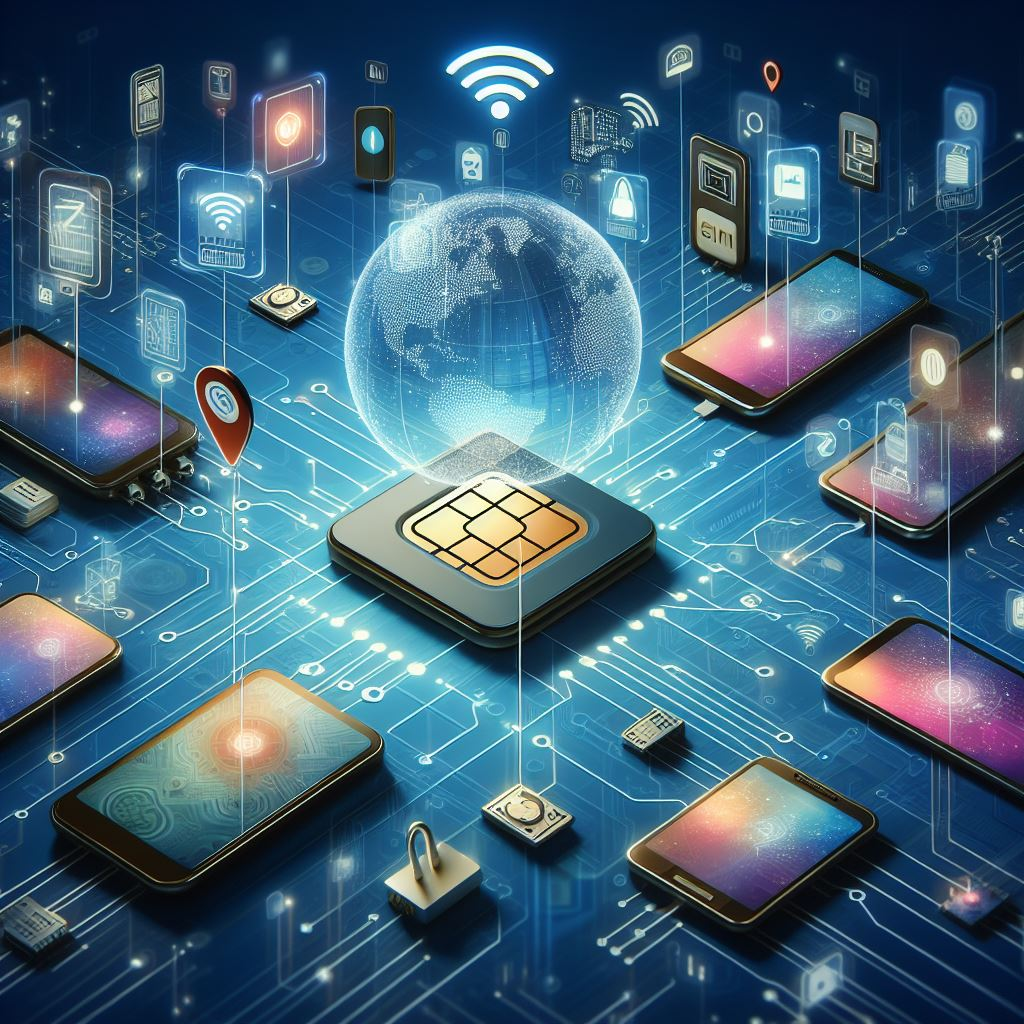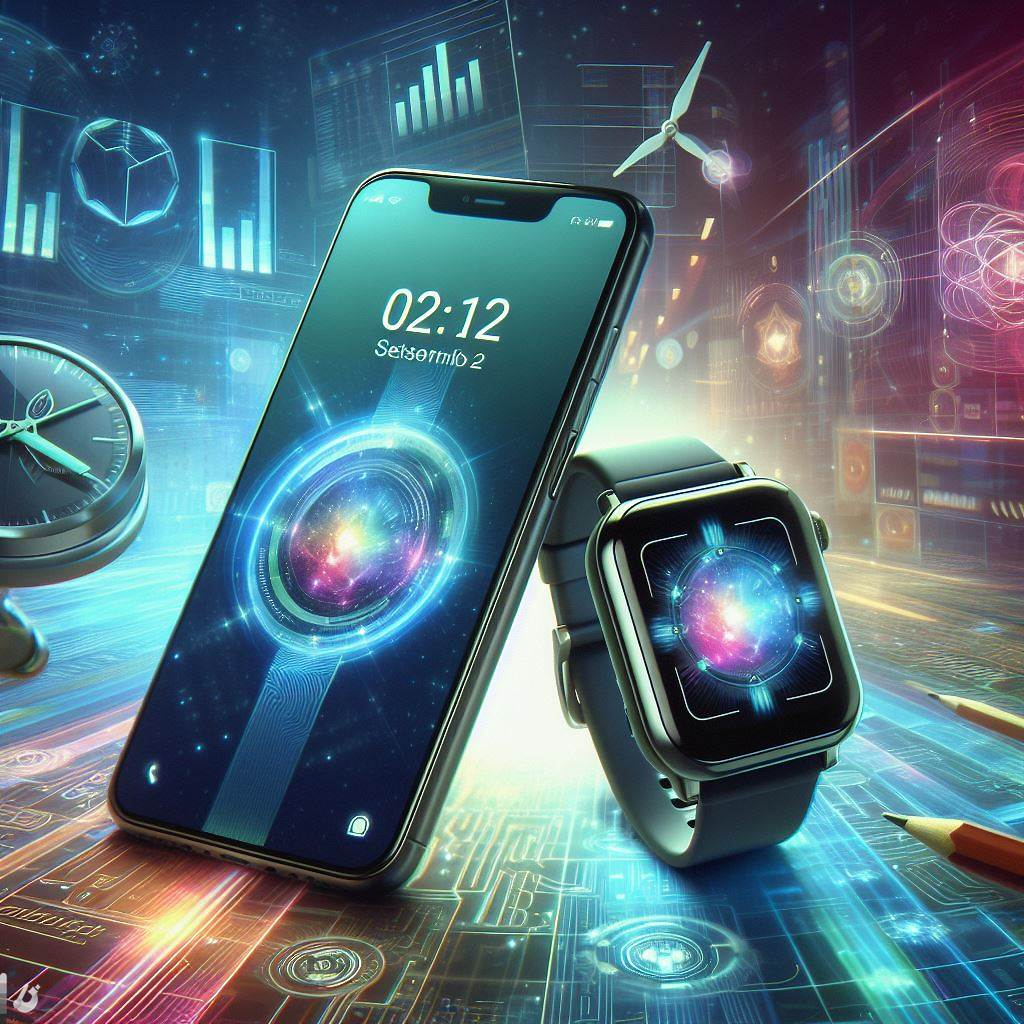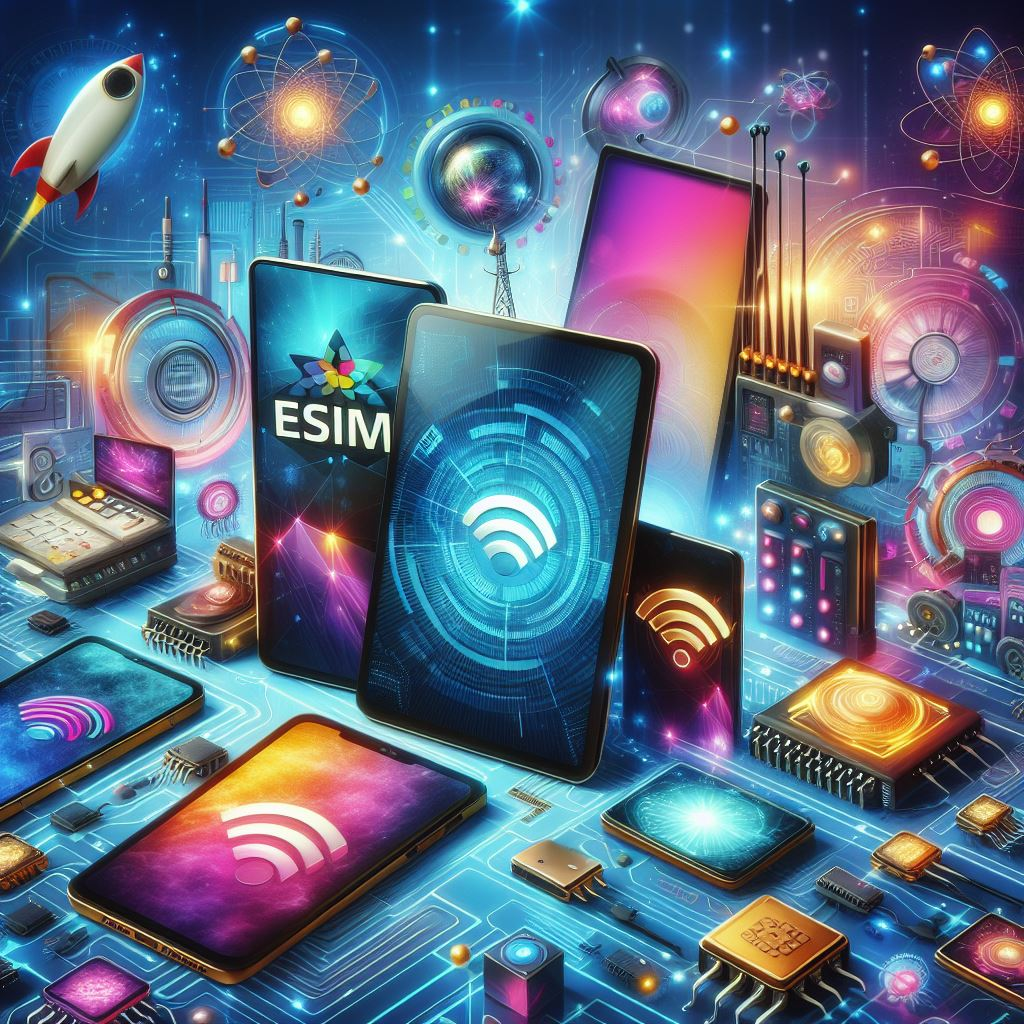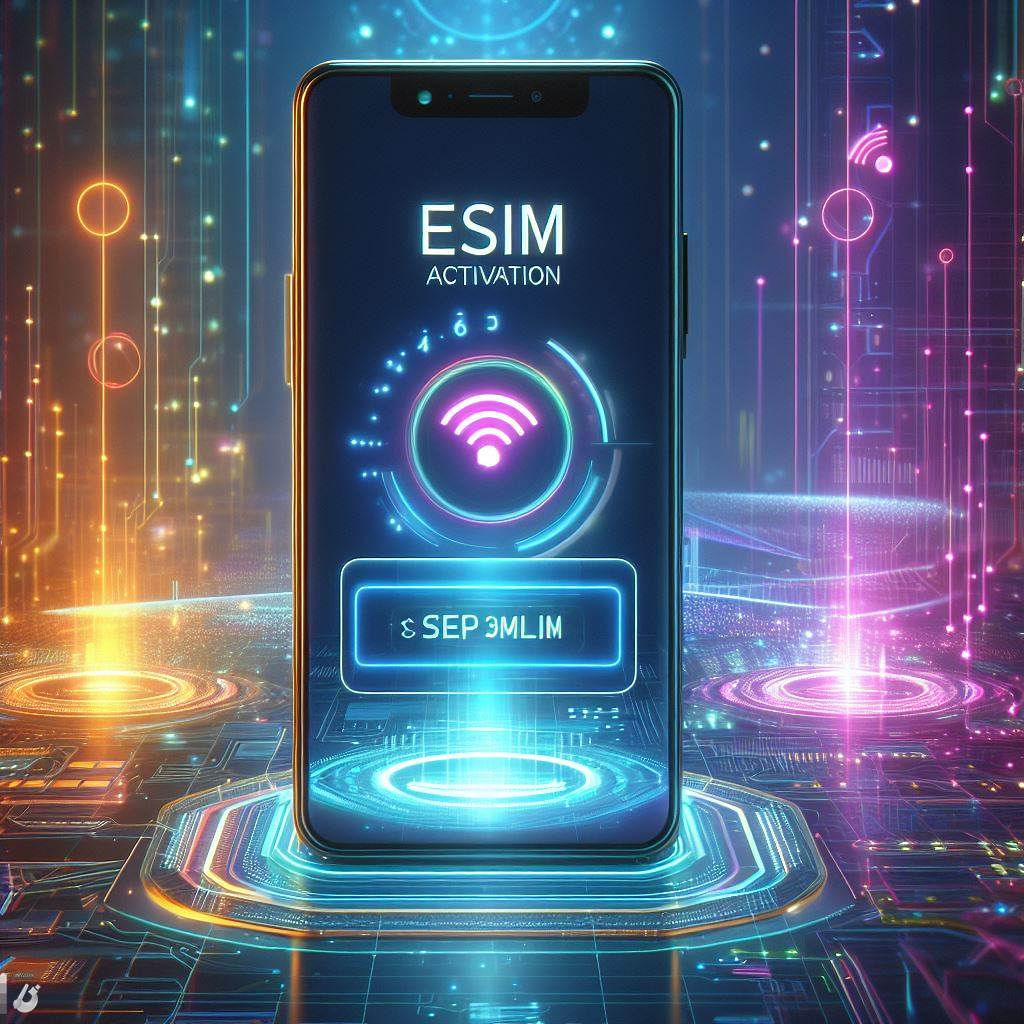- Home
- •
- Blog
- •
- What is eSIM?
What is eSIM?
Author
Uliana Aitakayeva
Published on
Jan 10 2024

Understanding eSIM Technology: A Breakthrough in Cellular Connectivity

Revolutionizing the Mobile Experience.
eSIM technology, also known as embedded SIM cards, is a breakthrough in mobile connectivity. It provides a revolutionary alternative to the traditional removable SIM card that has been used in mobile devices for decades. But what exactly is eSIM and how does it differ from the familiar physical SIM card?
To put it simply, eSIM is a built-in subscriber identity module that is embedded directly into a device, such as a smartphone or wearable. Unlike physical SIM cards, which are removable and can only be used with one device at a time, eSIM eliminates the need for a physical card and allows users to switch between multiple networks without needing to swap out physical SIM cards. This means that devices with eSIM capabilities can be more flexible and convenient for users, as they can easily switch between different mobile networks without any physical changes. It also opens up new possibilities for seamless connectivity in devices that are too small to accommodate traditional SIM cards.
The advent of eSIM technology is set to reshape the mobile industry by providing users with more choice and flexibility. In addition to the convenience of not having to physically switch SIM cards, eSIM also allows for easier activation and set-up processes. With eSIM, users can activate their devices remotely and instantly connect to their chosen mobile network. This not only saves time and effort, but also eliminates the need for physical SIM cards and the associated waste that comes with them. As eSIM adoption and support continues to grow, we can expect to see more devices and carriers embracing this technology, leading to enhanced mobile experiences for users around the world.
The Evolution of SIM Cards: From a Physical SIM Card to an Embedded SIM Card
The evolution of SIM cards has come a long way from their physical form to the current embedded technology. With the introduction of the iPhone XS, which is equipped with an embedded SIM (eSIM) technology, the landscape of mobile devices has transformed. Gone are the days when users had to insert a traditional SIM card into their mobile devices. Now, the eSIM technology allows for the seamless connectivity of devices to mobile networks without the need for a physical SIM card slot.
The emergence of the eSIM technology has paved the way for a more streamlined and convenient user experience. By eliminating the need for a physical SIM card, mobile device manufacturers can design sleeker and more compact devices. Additionally, users no longer have to worry about misplacing or damaging their SIM cards. The eSIM technology also allows for easy switching between mobile networks, making it ideal for users who frequently travel or require multiple network options. As the mobile industry continues to embrace the advancements in eSIM technology, we can expect further enhancements in connectivity and a more seamless mobile experience.
Exploring the Benefits of eSIM Technology for Mobile Devices

Effortless Device Management.
The emergence of eSIM technology has brought several benefits for mobile devices. One of the key advantages is the elimination of the traditional SIM card. With eSIM, there is no longer a need for a physical card to be inserted into the device. Instead, the SIM card information is embedded directly into the device itself. This means that users no longer have to worry about misplacing or damaging their SIM card, which can be a common issue with traditional physical SIM cards. Additionally, having an eSIM means that users can easily switch between different carriers that support eSIM without the need for a physical card swap. This provides a great level of flexibility for users who want to switch carriers or when traveling to a different country.
The support for eSIM by various carriers further enhances the benefits of this technology for mobile devices. Major carriers offer eSIM support, allowing their customers to take advantage of the benefits that come with eSIM technology. With eSIM support, users can easily activate a new mobile phone number on their device without the need for an additional physical SIM card. This is particularly convenient for individuals who frequently switch between multiple mobile phone numbers, such as business professionals or frequent travelers.
Additionally, having eSIM support from carriers means that users can easily switch between different carriers without having to go through the hassle of physically changing their SIM card, making it a seamless process.
eSIM vs Physical SIM: Which is Right for You?
eSIM technology has been making waves in the mobile industry, offering users a new way to connect their devices without the need for a physical SIM card. With traditional physical SIM cards, users require a physical sim slot in their devices to insert and switch between different SIM cards for different networks. On the other hand, eSIM technology enables users to have virtual SIM cards that are embedded directly into their devices.
One of the key benefits of eSIM technology is the convenience it provides, especially for users who frequently travel or switch between multiple networks. With eSIM, there is no need to physically swap SIM cards, making it easier to manage network connections on the go. This is particularly advantageous for iPhone models that have eSIM support, as users can have two different phone numbers on one device.
Additionally, eSIM technology allows for remote SIM provisioning, which means users can activate a new mobile plan or switch to a different network provider without needing a physical SIM card. This flexibility extends to phone calls and mobile data usage, as users can easily switch between networks to optimize coverage and cost without the need for physical SIM card swapping.
How eSIM Technology is Revolutionizing Mobile Networks

Next-Gen Mobile Infrastructure.
eSIM technology has brought about a significant revolution in mobile networks, transforming the way we connect and communicate. With the emergence of eSIM, traditional removable SIM cards are becoming a thing of the past. Leading telecom provider Global Yo is one of the frontrunners in adopting this virtual SIM technology. By leveraging eSIM, Global Yo's subscribers can now enjoy seamless activation and smooth transitions between devices simply by scanning a QR code.
The benefits of eSIM extend beyond the convenience of eliminating physical SIM cards. For iPhone users, Global Yo's support for eSIM means they can effortlessly switch between multiple carriers and plans without the hassle of swapping SIM cards. Moreover, eSIM opens up new possibilities for wireless service, allowing users to enjoy the flexibility of managing their plans directly from their device. With eSIM, Global Yo customers can experience hassle-free connectivity and enjoy unlimited data seamlessly, without compromising on the quality of their mobile experience.
Unlocking the Potential of eSIM: A Game-Changer for iPhone XS Users
The adoption of eSIM technology has unlocked new possibilities for iPhone XS users, revolutionizing the way we use our cell phones. With eSIM, users no longer need to physically insert a SIM card into their devices. Instead, eSIM can be embedded directly into the device itself, allowing for a seamless and hassle-free connectivity experience. This is especially beneficial for individuals who own multiple devices or frequently travel, as they can easily switch between different eSIM compatible devices, such as their iPhone and Apple Watch, using a dual SIM feature. Gone are the days of carrying multiple physical SIM cards or swapping them out when switching between devices. With eSIM, users can enjoy the convenience of having all their cellular connections managed on the same device.
One of the key advantages of eSIM is its ability to provide enhanced connectivity while simplifying the user experience. The embedded nature of eSIM eliminates the need for physical SIM cards, reducing the risk of losing or damaging them. Additionally, users no longer need to go through the process of obtaining a physical SIM card from a carrier. Instead, they can easily activate an eSIM and connect to their desired network directly on their iPhone XS. This level of simplicity and convenience further reinforces the potential of eSIM technology as a game-changer in the mobile industry. Whether it's for business or personal use, iPhone XS users can now enjoy a streamlined and effortless cellular experience with eSIM devices.
The Future of Connectivity: How eSIM is Reshaping the Mobile Industry

Seamless Integration in Every Device.
In today's ever-evolving world of mobile technology, the future of connectivity lies in the hands of eSIM technology. Gone are the days of physical SIM cards and the constant need to switch them out when changing phones or cellular providers. With eSIM adoption on the rise, users can enjoy the convenience of storing multiple phone numbers on a single device, without the hassle of physically swapping SIM cards.
eSIM technology is reshaping the mobile industry by offering a new level of flexibility and convenience for users. This virtual SIM card is embedded directly into the device, eliminating the need for a physical card. With eSIMs, users can easily switch between cellular providers without having to acquire a new SIM card, making it a game-changer for travelers or those who frequently change networks. The seamless integration of eSIMs also ensures a more reliable and secure mobile network connection, allowing users to stay connected no matter where they are. Whether you own an iPhone XS or a Google Pixel, more and more devices are stepping up to support eSIM, signaling the immense potential for this technology in the near future.
Demystifying eSIM: Everything You Need to Know About this Virtual SIM
eSIM, also known as electronic SIM or embedded SIM, is a digital version of the traditional physical SIM cards that we are accustomed to using in our smartphones. With eSIM services, there is no longer a need for a physical SIM card and the hassle of inserting it into the SIM card tray of our devices. Instead, the SIM card information is stored directly on the device itself.
One of the key advantages of eSIM is its flexibility. With physical SIMs, switching phones meant transferring the SIM card to the new device and manually transferring our contacts. However, with eSIM, switching phones becomes a breeze. All we need to do is scan a QR code or download the profile from our service provider, and we are good to go. All our contacts and settings are seamlessly transferred, eliminating the time-consuming task of manually transferring contacts. This convenience makes eSIM an attractive option for individuals who frequently change devices or travel frequently.
eSIM Adoption and Support: Which Carriers are Embracing the Technology?

Seamless Connectivity Across Networks.
eSIM technology has gained significant traction in recent years, and more and more carriers are embracing this innovative solution for mobile connectivity. As the demand for seamless connectivity grows, carriers worldwide are recognizing the benefits and potential of eSIM. With the transition from physical SIM cards to embedded chips, consumers can now enjoy a hassle-free experience when it comes to managing their devices.
The support for eSIM is expanding rapidly, with a wide range of carriers now offering compatibility for consumer devices. Major players such as Global Yo have embraced eSIM technology, making it easier for consumers to switch between carriers and activate their eSIM profiles. Additionally, other carriers like Vodafone, Orange, and EE are also joining the eSIM revolution, providing their customers with the flexibility and convenience of eSIM-enabled devices.
Enhancing Mobile Experiences with eSIM: A Look into the Future of Wireless Service
With the emergence of eSIM technology, the future of wireless service is set to be revolutionized. Gone are the days of physical SIM cards and the limitations they bring. Instead, eSIM profiles can be easily downloaded onto compatible devices, allowing users to seamlessly switch between local carriers and connect to the carrier's network without the need for a physical SIM swap. This means that travelers can enjoy the convenience of local service providers without the hassle of obtaining a new physical SIM card every time they visit a different country. Furthermore, the eSIM technology opens up a world of possibilities beyond traditional mobile connectivity.
Imagine a scenario where the eSIM technology not only enhances mobile connectivity but also integrates with other features of your smartphone. With just a few taps in your phone's settings app, you can switch between eSIM profiles and utilize the optimal carrier for different situations. Whether you want to ensure the fastest data speeds for streaming content on your phone's camera, or require a reliable connection for video calls, the flexibility of eSIM compatible smartphones allows for a personalized and optimized mobile experience.
eSIM Devices and Compatibility: Which Smartphones and Wearables Support eSIM?

Smart Choices: eSIM-Enabled Devices.
With the increasing popularity of eSIM technology, many device makers and smartphone manufacturers have started incorporating eSIM support into their products. This allows users to easily switch between different cellular plans without the need to physically swap out SIM cards. The activation process for eSIMs is also streamlined, as it can be done remotely without the need for a physical SIM card.
eSIM compatibility is now available on a wide range of devices, including smartphones, tablets, smartwatches, and even some laptops. This means that users who own multiple devices can now conveniently manage their cellular plans on one device and share them with other eSIM-compatible devices.
In addition to the convenience it provides, eSIM technology also helps save space inside devices, making it possible for manufacturers to create slimmer and sleeker designs. As the demand for eSIM devices continues to grow, we can expect to see more and more device makers embracing this technology in their new devices.
eSIM Activation and Set-Up: A Step-by-Step Guide to Getting Started with eSIM
The activation and set-up process for eSIM is a simple and straightforward experience that allows users to seamlessly transition from a physical SIM card to an embedded one. To begin, ensure that your device supports eSIM technology and that your network carrier provides eSIM support. Check with your carrier to verify their eSIM compatibility and availability.
Once you have confirmed compatibility, you can request an eSIM activation code from your carrier. This code will be used to activate the eSIM on your device. It is important to note that during the activation process, you should have a Wi-Fi or cellular data connection available, as the eSIM activation requires it.
Additionally, it is worth mentioning that emergency services are supported on eSIM-enabled devices, offering peace of mind in critical situations. With the eSIM standard becoming more prevalent in the mobile industry, the activation and set-up process is becoming increasingly streamlined, ensuring a hassle-free experience for users.

Unlocking eSIM Potential.
What is eSIM technology?
eSIM technology stands for embedded SIM, which is a virtual SIM card that is built into a device, such as a smartphone or wearable. It allows users to activate a mobile plan without the need for a physical SIM card.
How does eSIM technology work?
eSIM technology works by using a chip that is embedded in the device. Users can activate a mobile plan by scanning a QR code or through a mobile app. The eSIM securely stores user credentials and allows for easy switching between mobile networks.
What are the benefits of eSIM technology?
eSIM technology offers several benefits, including the ability to switch between mobile networks without physically changing SIM cards, easier activation and setup process, and increased flexibility for travelers. It also allows for remote provisioning and management of mobile plans.
What is the difference between eSIM and physical SIM cards?
The main difference between eSIM and physical SIM cards is that eSIM cards are embedded in the device, while physical SIM cards need to be physically inserted and removed. eSIMs also offer more flexibility in terms of switching between mobile networks.
Is eSIM technology available for iPhone XS users?
Yes, eSIM technology is available for iPhone XS users. The iPhone XS supports dual SIM functionality, allowing users to have both a physical SIM card and an eSIM active at the same time.
How is eSIM reshaping the mobile industry?
eSIM is reshaping the mobile industry by enabling easier device activation and setup, reducing the need for physical SIM cards, and increasing flexibility for users. It is also paving the way for new business models, such as embedded connectivity in IoT devices.
What do I need to know about eSIM as a virtual SIM?
eSIM is a virtual SIM that is embedded in a device, eliminating the need for a physical SIM card. It securely stores user credentials and allows for easy switching between mobile networks. Users can activate and manage eSIMs through a QR code or a mobile app.
What is the future of wireless service with eSIM?
The future of wireless service with eSIM looks promising. It will likely lead to increased convenience for users, more seamless connectivity across devices, and greater flexibility in managing mobile plans. It may also open up new opportunities for innovative services and applications.
Which smartphones and wearables support eSIM?
Several smartphones and wearables support eSIM technology, including iPhones (iPhone XS, iPhone XR, iPhone 11, etc.), Google Pixel devices, Samsung Galaxy watches, and various smartwatches from other manufacturers. It is important to check the device specifications to confirm eSIM compatibility.
How do I activate and set up eSIM on my device?
To activate and set up eSIM on your device, follow these steps: 1. Check if your device supports eSIM technology 2. Contact your carrier to ensure the eSIM service is available and activate it 3. Obtain an eSIM QR code or download a mobile app from your carrier to set up the eSIM 4. Scan the QR code or follow the instructions in the mobile app to complete the activation process 5. Choose your desired mobile plan and configure the settings 6. Your eSIM is now activated and ready to use.
Uliana Aitakayeva
[email protected]Uliana Aitakayeva is a tech-savvy traveler with a deep understanding of eSIM technology. As a telecom engineer, she offers practical advice on using eSIMs worldwide. Her posts focus on cost-effective strategies, carrier insights, and regional tips. When not traveling, Uliana enjoys photography and exploring local cuisines.
